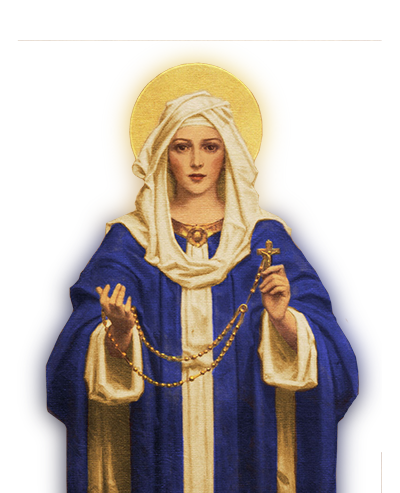Discover the rich tradition of honoring Our Lady of the Rosary. Explore the history, significance, and practices of this timeless devotion.
Have you ever wondered about the significance of the devotion to Our Lady of the Rosary? The Catholic Church has a rich tradition of honoring the Virgin Mary under various titles and devotions. One of the most beloved and widely practiced devotions is that of Our Lady of the Rosary. Let’s explore the history, significance, and practices associated with this devotion that transcends age and time.

Origins of the Devotion
Let’s start by delving into the origins of the devotion to Our Lady of the Rosary. The history of the Rosary dates back to the Middle Ages, with its roots intertwined in the prayer practices of the Catholic faith. The Rosary consists of a set of prayers, divided into groups of ten beads called decades. Each decade is focused on a different mystery from the life of Jesus and Mary, helping believers meditate on the key aspects of their faith.
St. Dominic and Our Lady of the Rosary
Legend has it that the devotion to the Rosary was revealed to St. Dominic in a vision from the Virgin Mary in the early 13th century. According to tradition, Mary appeared to St. Dominic and instructed him to teach the faithful to pray the Rosary as a way to combat heresies and promote peace in the world. St. Dominic, along with his fellow Dominicans, spread the devotion to the Rosary throughout Europe and beyond, leading to its widespread popularity.
Feast of Our Lady of the Rosary
One of the key aspects of the devotion to Our Lady of the Rosary is the celebration of the Feast of Our Lady of the Rosary on October 7th. This feast day commemorates the victory of the Christian fleet over the Ottoman Turks at the Battle of Lepanto in 1571. Pope St. Pius V attributed the victory to the intercession of the Virgin Mary through the Rosary, and he established the feast to honor Our Lady of the Rosary. The feast serves as a reminder of the power of prayer and the intercession of Mary in times of great need.

Devotional Practices
Now, let’s take a closer look at the devotional practices associated with Our Lady of the Rosary. The devotion to the Rosary involves both prayer and meditation on the mysteries of the life of Jesus and Mary. Practicing the Rosary can be a deeply spiritual experience that brings believers closer to God and Mary.
How to Pray the Rosary
Praying the Rosary involves reciting a set of prayers while meditating on the mysteries of the Rosary. The basic structure of the Rosary includes the Apostles’ Creed, the Our Father, three Hail Marys, and the Glory Be, followed by the five decades of mysteries. The mysteries are divided into four sets: the Joyful, Sorrowful, Glorious, and Luminous mysteries, each focusing on different aspects of the lives of Jesus and Mary.
Meditating on the Mysteries
Meditating on the mysteries of the Rosary is an essential part of the devotion. The mysteries provide believers with a framework for reflecting on the key events in the lives of Jesus and Mary. By meditating on the mysteries, believers can deepen their understanding of the Christian faith and draw closer to God. The practice of meditating on the mysteries also helps to cultivate a spirit of prayer and contemplation in everyday life.
Benefits of the Rosary
Practicing the devotion to Our Lady of the Rosary offers a multitude of benefits for believers of all ages. The Rosary is a powerful tool for spiritual growth, helping believers to deepen their relationship with God and Mary. Some of the key benefits of the Rosary include:
- Increased focus and concentration during prayer
- Deepened understanding of the mysteries of the faith
- Strengthened faith and trust in God’s providence
- Inner peace and comfort in times of need
- Sense of connection to the universal Church through shared prayer

Mary, Our Intercessor
Central to the devotion to Our Lady of the Rosary is the belief in Mary’s role as a powerful intercessor before God. Catholics believe that Mary, as the Mother of Jesus, holds a special place in the economy of salvation and can intercede on behalf of believers. The Rosary serves as a means of seeking Mary’s intercession in times of need and offering prayers of thanksgiving and petition.
Mary, Mother of Mercy
Mary is often referred to as the Mother of Mercy, a title that highlights her compassionate and loving nature. Catholics turn to Mary as a source of comfort and solace, trusting in her maternal care and concern for their well-being. The Rosary is a way for believers to seek Mary’s intercession for their needs, both spiritual and temporal, knowing that she will always listen to their prayers with a mother’s heart.
The Power of Intercessory Prayer
Intercessory prayer is a powerful form of prayer that involves asking the saints, including Mary, to pray on behalf of believers. Catholics believe that the saints, as members of the communion of saints, can intercede for them before God. The Rosary provides a structured and meaningful way to engage in intercessory prayer, with each Hail Mary serving as a petition to Mary for her prayers on behalf of the faithful.
Examples of Marian Intercession
Throughout history, there have been many examples of Mary’s intercession on behalf of believers. From the miraculous healings attributed to her intercession to the protection and guidance she provides to her children, Mary’s intercession is a source of hope and inspiration for Catholics around the world. The devotion to Our Lady of the Rosary is a testament to the power of Mary’s intercession and the importance of seeking her help in times of need.

The Rosary in Everyday Life
The devotion to Our Lady of the Rosary is not just a prayer practice reserved for special occasions or specific times of day. The Rosary can be a meaningful part of everyday life, providing believers with a source of comfort, guidance, and strength in their daily activities.
Morning Offering
Many Catholics begin their day by praying the Rosary as part of their morning offering. The Rosary can help believers center their thoughts and intentions on God and Mary as they prepare to face the challenges of the day ahead. By starting the day with the Rosary, believers can seek Mary’s intercession for their needs and offer their day to God in prayer.
Evening Prayer
The Rosary can also be a comforting way to end the day in prayer and reflection. Before going to bed, many Catholics recite the Rosary as a way to reflect on the events of the day, seek forgiveness for any sins or shortcomings, and entrust themselves to God and Mary’s care during the night. The Rosary can bring a sense of peace and tranquility to the evening hours, helping believers to rest in the assurance of God’s love and protection.
Praying with Family and Friends
The Rosary is a communal prayer that can be shared with family and friends. Many Catholics gather with loved ones to pray the Rosary together, strengthening their bonds of faith and unity. Praying the Rosary as a group can bring a sense of solidarity and support to believers, as they join together in seeking Mary’s intercession for their intentions and offering prayers of thanksgiving and praise.

Conclusion
In conclusion, the devotion to Our Lady of the Rosary is a timeless practice that holds significance for believers of all ages. From its origins in the Middle Ages to its continued popularity in the present day, the Rosary continues to be a powerful source of spiritual growth and comfort for Catholics around the world. By praying the Rosary, believers can deepen their relationship with God and Mary, draw closer to the mysteries of the faith, and seek the intercession of Mary in times of need. May the devotion to Our Lady of the Rosary bring you closer to God and Mary, guiding you in your faith journey and inspiring you to live a life of prayer and devotion.
